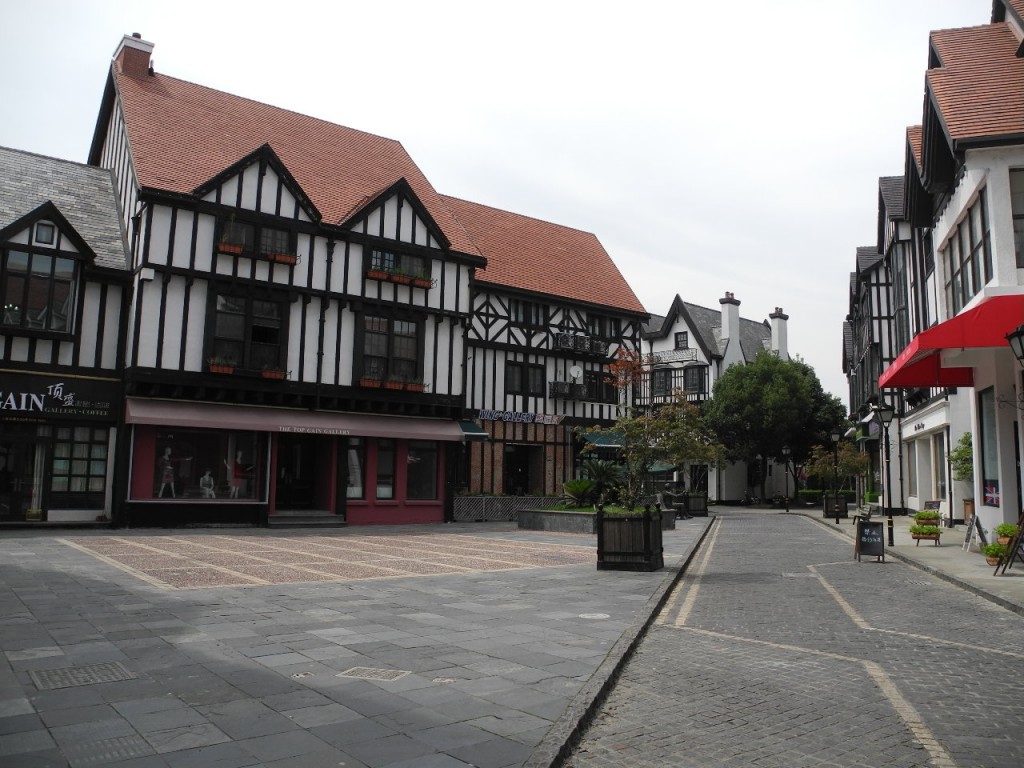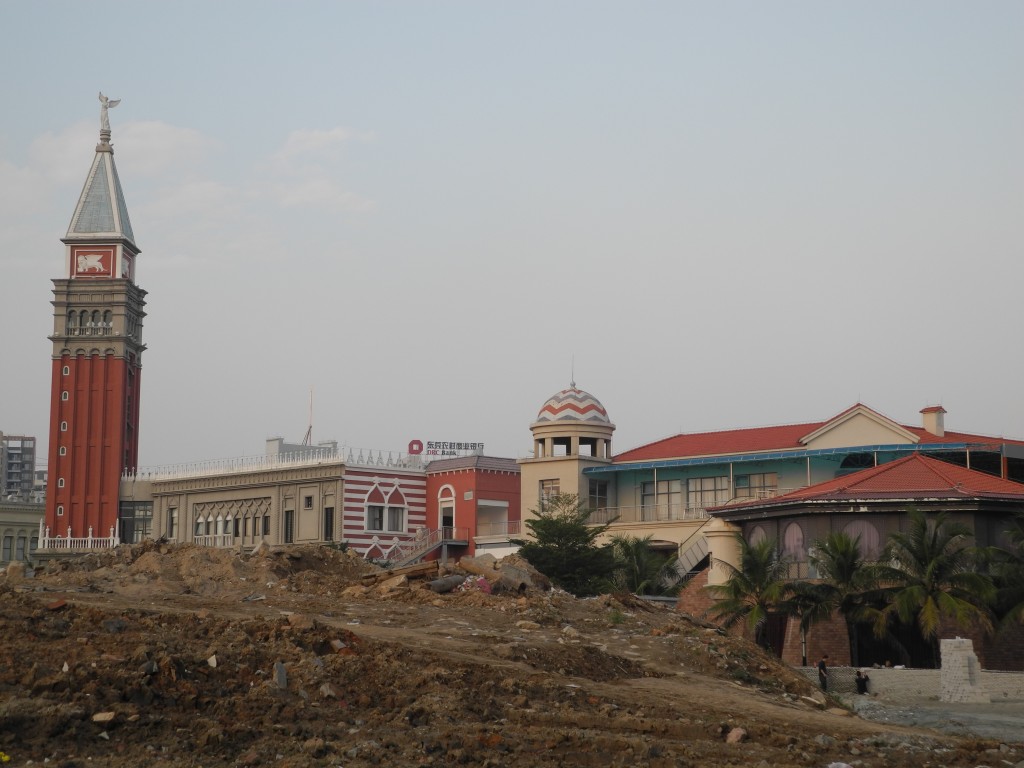Latest topics
The myth of China’s ghost cities
2 posters
Page 1 of 1
 The myth of China’s ghost cities
The myth of China’s ghost cities

Thames Town, near Shanghai, China. REUTERS/Courtesy of Wade Shepard
Ghost towns tend to start as boomtowns, and contemporary China more than likely has more boomtowns than any other country in history. No economy has ever risen so rapidly and no place has ever built so much so quickly. This rapid growth has resulted in peculiar side effect: ghost cities, everywhere.
Although the term “ghost town” is technically a misnomer in this case. A ghost town is a place that has become economically defunct — in other words, a place that has died. What China has is the opposite of ghost towns: It has new cities that have yet to come to life.
There are nearly 600 more cities in China now than there were when the Communist Party took over in 1949. This large-scale urban transition began in the early 1980s, when rural areas began being rezoned as urban en masse and the city took center stage in China’s plans for the future. In the early 2000s this urbanization movement was kicked into high gear. New urban developments began popping up seemingly everywhere — along the outskirts of existing cities as well as in the previously undeveloped expanses between them. Many cities doubled or even tripled their size within relatively short spans of time. In just 15 years Shanghai alone grew sevenfold and its population increased to more than 23 million from 6.61 million.

Pujiang’s Italian-style New Town, near Shanghai. REUTERS/Courtesy of Wade Shepard
China’s broader urbanization movement shouldn’t be thought of as a developmental free-for-all. There is a method behind all of this building and an overarching framework. Ten massive new urban conglomerations called mega-regions have been proposed in strategic locations across the country. These are essentially city clusters of 22 million to more than 100 million people each that are to be connected through infrastructure, economically, and, potentially, even politically.
China’s fiscal policy all but requires local municipalities to comply with this broader urbanization plan. According to the World Bank, local municipalities must fend for 80 percent of their expenses while only receiving 40 percent of the country’s tax revenue. Land sales make up much of the difference, resulting in a buy low, sell high scheme, as municipalities buy up cheap rural land, re-designate it as urban, and then resell it at the high urban construction land rate — pocketing the difference. According to China’s Ministry of Finance, land sales raised $438 billion for China’s local governments in 2012 alone.
When developers purchase these new plots of land, they are prohibited by law from sitting on them. They must build something. While it is commonly thought that getting in on a new development zone early is key to making a big profit, these areas tend to lie far outside the bounds of mature, built-up urban areas. This often means constructing vast apartment complexes, giant malls and commercial streets in places that do not yet have much of a population base to support them.
Building a new city from the ground up is a long-term initiative, a process that China estimates takes roughly 17 to 23 years. By 2020, Ordos Kangbashi plans to have 300,000 people, Nanhui expects to attract 800,000 residents and 5 million people are slated to live in Zhengdong New District. China’s new cities are just that: new.

The South China Mall, in Guangdong province, is the largest in the world, but it’s mostly empty. REUTERS/Courtesy of Wade Shepard
There is hardly a single new urban development in the country that has yet gone over its estimated time line for completion and vitalization, so any ghost city labeling at this point is premature: Most are still works in progress. But while building the core areas of new cities is something that China does with incredible haste, actually populating them is a lengthy endeavor.
When large numbers of people move into a new area, they need to be provided for; they need public services like healthcare and education. Therefore, a population carries a price tag and there is often an extended period of time between when cities appear completed and when they are actually prepared to sustain a full-scale population. This could be called the “ghost city” phase.
Most large new urban developments in China eventually move through this phase and become vitalized with businesses and a population. Essential infrastructure gets built, shopping malls open, and places where residents can work are created. In many of the biggest new cities, new university campuses will emerge and government offices and the headquarters of banks and state owned enterprises will be shipped in, essentially seeding these fresh outposts of progress with thousands of new consumers. From here, more businesses are attracted — often drawn by favorable subsidies like free rent — and more people trickle in as the city comes to life.
Some of China’s most notorious ghost cities saw phenomenal population growth in recent years, according to a [url=https://research.standardchartered.com/configuration/row documents/china_property__mystery_of_ghost_cities_23_05_14_13_12.pdf]report[/url] by Standard Chartered. In just a two year period from 2012 to 2014, Zhengdong New District’s occupancy rate rose doubled, while Dantu’s quadrupled and Changzhou’s Wujin district increased to 50 percent from 20 percent. Though there is still an excess of vacancies in these places, when urban areas of high-density housing are even half full there’s still a large number of people living there — more than enough for the place to socially and economically function as a city.
It generally takes at least a decade for China’s new urban developments to start breaking the inertia of stagnation. But once they do, they tend to keep growing, eventually blending in with the broader urban landscape and losing their “ghost city” label.
http://blogs.reuters.com/great-debate/2015/04/21/the-myth-of-chinas-ghost-cities/

Ponee- Admin

- Posts : 38267
Join date : 2011-08-09
 Re: The myth of China’s ghost cities
Re: The myth of China’s ghost cities
It will be more empty when the chinese all move to the U.S., seeing how they own alot of it anyway, thanks to 'Odumbass'-

Terbo56- VIP Member

- Posts : 13675
Join date : 2011-06-18
Age : 67
Location : Central Florida-
Page 1 of 1
Permissions in this forum:
You cannot reply to topics in this forum

» Phony Tony sez: Full Steam Ahead!
» Dave Schmidt - Zim Notes for Purchase (NOT PHYSICAL NOTES)
» Russia aren't taking any prisoners
» Deadly stampede could affect Iraq’s World Cup hopes 1/19/23
» ZIGPLACE
» CBD Vape Cartridges
» Classic Tony is back
» THE MUSINGS OF A MADMAN
» Minister of Transport: We do not have authority over any airport in Iraq
» Did Okie Die?
» Hello all, I’m new
» The Renfrows: Prophets for Profits, Happy Anniversary!
» What Happens when Cancer is treated with Cannabis? VIDEO
» An Awesome talk between Tucker and Russell Brand
» Trafficking in children
» The second American Revolution has begun, God Bless Texas
» The Global Currency Reset Evolution Event Will Begin With Gold, Zimbabwe ZWR Old Bank Notes
» Tucker talking Canada
» Almost to the end The goodguys are winning